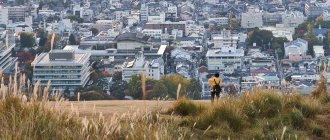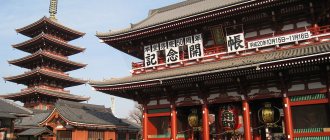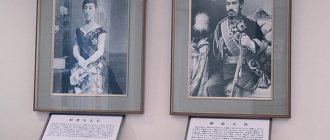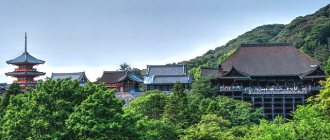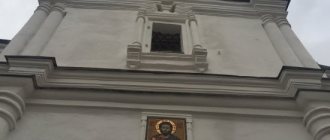Todai-ji (Japanese: 東大寺) is an ancient Buddhist temple in Japan in the city of Nara. The temple is protected as a UNESCO World Heritage Site.
The temple represents the center of the Kegon tradition.
Todai-ji Temple is considered the largest wooden structure in the world. It houses a giant bronze statue of Buddha Vairocana.
The temple area is a deer park where sacred deers roam freely and are fed by tourists. On the territory of the temple complex there are a large number of unique structures, in particular the February Nigatsu-do pavilion, the March Sangatsu-do pavilion and other pagodas and temples.
Story
The main attraction of Nara was founded in 743 by decree of Emperor Shomu. More precisely, the ruler ordered the construction of a giant Buddha statue to begin, which was supposed to help gain the favor of the gods and bring peace to the country torn apart by civil strife.
The temple complex was built by the joint efforts of more than two million people. The design of the pavilion and statue was developed by Kuninaka-no-Muraji Kimimaro, a native of the capital’s Korean community. It took the master and his assistants more than a year to make the clay forms alone. The throne, body and head and neck were made separately, and then soldered together and covered with a layer of gold. By the way, it was possible to assemble the giant statue only on the eighth attempt.
Almost all the forces of the state were mobilized to build a relic of this scale. The craftsmen burned more than 10,000 tons of coal and used more than 7.5 tons of wax. The implementation of Kimimaro's project required most of the bronze mined in the country and more than 150 kilograms of pure gold. The construction of the statue was not the only difficulty - the bronze deity needed decent shelter from the weather, and a spacious pavilion was built around the seated Buddha.
In 752, during a magnificent ceremony with the participation of the imperial couple, the eyes of the Big Buddha were “opened” - while reading the sacred sutras, a drawing on the bronze face of the statue was made by a monk specially invited from distant India.
The buildings of the complex suffered more than once from natural disasters - the temple burned to the ground twice, and after a strong earthquake in 1709, the two most damaged pagodas were dismantled. The sanctuary acquired its current appearance after the restoration in 1913. According to some reports, now it occupies no more than a third of the original volume, but, nevertheless, remains the largest wooden structure on the planet.
Great feat in the name of Buddhism
The sanctuary acquired its modern appearance only after 1913. The great reconstruction began in 1903, and the complete restoration of the temple took more than 10 years. Pilgrims and tourists can enter the temple through the South Gate. The entrance to the temple is guarded by two huge monsters, between which a breathtaking view of the main Buddha statue opens.
Anyone who sees this building for the first time will immediately come to mind: the Japanese, even in those distant times, paid close attention to the smallest details. Dainichi Buddha sits on a throne, which in turn represents a lotus flower, a popular symbol in the Buddhist religion.
The face of the Japanese deity expresses complete peace and tranquility. Any monk will say that this statue is meant to symbolize the divine manifestation of higher powers, as well as the presence of the Buddha himself in any place.
All guests of the most revered temple should pay attention to the passage between the supporting columns. It is believed that the person who passes here will become the happiest in the world.
What to see
The entrance to the temple territory is marked by a massive gate - Nandaimon. 18 columns made from solid trunks of huge trees support a two-tiered roof, and the passage is guarded by a pair of mythical monsters Nyo. The building of the temple itself is designed in the best traditions of Japanese architecture - smooth curves of the roofs, intricate carvings and lacquer painting - the masterfully executed rich decoration of the temple speaks of its most important religious status in the Land of the Rising Sun.
The dimensions of Daibutsu-den are impressive - its height is about 50 m, its length is 57 m, and its total area is almost 3000 square meters. m. Even now, this powerful wooden structure amazes tourists who have seen a lot with its dimensions, and in the 8th century it was considered a real divine miracle and the pinnacle of the art of construction.
Inside the pavilion is the famous 500-ton statue of Buddha Vairocana. Todai-ji belongs to the Kegon Buddhist sect - the School of the Majesty of the Flower of Law, and is still an active temple: services are held here every day, monks read sacred sutras and light a ritual fire.
While examining the statue of the Big Buddha, try to imagine with what awe the residents of the ancient capital looked at the bronze giant: a golden throne in the shape of a lotus flower, covered with sacred texts, supports a massive figure; a huge palm, twice the size of a person, is folded in a blessing gesture, and eyes half-hidden by eyelids calmly look at the world from a 20-meter height.
The sculpture is a hollow structure supported from the inside by a wooden frame. Every year the sculpture is cleaned of soot and dirt, removing several buckets of dust. By the way, you can notice that the head and neck of the Buddha are slightly different in color from the torso - this is the result of repeated restorations.
Behind the Buddha there are 16 more human-sized statues - they symbolize the previous incarnations of the deity. Also in the pavilion are statues of Kannon, the goddess of mercy. And especially popular among tourists is the column, at the base of which there is a hole called “Buddha’s nostril.” According to legend, whoever can crawl through the hole will be freed from sins and will attract good luck.
On the grounds of Todai-ji is the Shosso-in Museum Pavilion, whose art collection is considered to be the oldest in the world. The simple log structure, built in the 8th century, was best suited for storing temple relics in the difficult conditions of the Japanese climate thanks to the original solutions of the ancient builders.
Shosso-in today houses an extensive collection of manuscripts, Buddhist relics, musical instruments, clothing, weapons and crafts. Of particular interest is a pair of richly decorated ritual swords - Yokohen and Inkohen. Only in 2010, museum staff confirmed that this was exactly the legendary gift of Empress Komyo, which was considered lost more than 1,250 years ago.
It is also worth visiting the Nigatsu-do and Sangatsu-do pavilions - their names translate respectively as the Hall of the second and the Hall of the third month. The February Pavilion takes its name from the sacred Xunye ritual that has been held here every year since the founding of the sanctuary. For two weeks, the monks of the temple pray to the Eleven-Faced Kannon for the atonement of the sins of humanity, and then symbolically burn all the filth in the flames of huge torches - after which, by the grace of the goddess, spring comes again to the world.
The March Hall is also known as the Lotus Hall - every spring, monks read sacred Buddhist sutras here. The pavilion contains many ritual scrolls and images, as well as a richly decorated statue of the Bodhisattva of Mercy, Fukukenjaku Kannon.
Todai-ji Temple in Japan
Todaiji Temple in Japan: history, description.
One of the oldest Buddhist temples in Japan is Todai-ji, in the city of Nara. First of all, this temple is known as the largest wooden structure in the world. In addition, within the walls of the temple there is a huge bronze statue of Buddha, which was smelted more than a thousand years ago! Construction of the temple began in the middle of the 8th century. It was at this time that Buddhism became widespread in the Land of the Rising Sun. The new religion had a strong impact on the art and architecture of the country. The construction of the Todaiji Temple dates back to the middle of the 8th century, when Buddhism, which had penetrated into Japan two centuries earlier, had already become the state religion and had a significant influence on the art and architecture of this country. At that time, the capital of the Japanese state was the city of Nara. Now Nara is one of the most revered holy places in the Land of the Rising Sun, where about 3 million pilgrims come annually. Here, on an area of about 525 hectares, there are several Buddhist and Shinto temples and idols with a long history.
Todaiji Temple occupies a central place among the shrines of Nara. For a long time it was the main state shrine of the country, and the name “Todaiji” literally means “Great Eastern Temple”. Todaiji Temple is widely known for its bronze sculpture of Dainichi Buddha (Daibutsu), which is the largest Buddha statue in Japan and one of the largest in the world. It was sculpted in 749 by a Korean sculptor, whom the Japanese call Kimimaro. To make the giant statue, it took 437 tons of bronze, 150 kilograms of gold, 7 tons of wax, 70 kilograms of mercury and several thousand tons of charcoal. According to legend, all the reserves of bronze in Japan were used up to cast the statue. The work was carried out over two years and was technologically extremely complex. Difficulties were caused not only by the casting process itself, but also by the installation and installation of the statue on a pedestal (taking into account the state of the art at that time!). After all, this phenomenal ancient structure weighs twice as much as the Statue of Liberty in New York, which was made eleven centuries later. How did the master manage to overcome all the technical obstacles? This remains a mystery, and the secret of making this unique monument of ancient foundry art has not yet been revealed.
THANK YOU FOR YOUR ATTENTION
Todai-ji is the largest wooden structure in the world
One of the oldest Buddhist temples in Japan is Todai-ji, in the city of Nara. First of all, this temple is known as the largest wooden structure in the world. In addition, within the walls of the temple there is a huge bronze statue of Buddha, which was smelted more than a thousand years ago! Construction of the temple began in the middle of the 8th century. It was at this time that Buddhism became widespread in the Land of the Rising Sun. The new religion had a strong impact on the art and architecture of the country.
The construction of Todaiji Temple dates back to the middle of the 8th century, when Buddhism, which had penetrated into Japan two centuries earlier, had already become the state religion and had a significant influence on the art and architecture of this country. At that time, the capital of the Japanese state was the city of Nara. Now Nara is one of the most revered holy places in the Land of the Rising Sun, where about 3 million pilgrims come annually. Here, on an area of about 525 hectares, there are several Buddhist and Shinto temples and idols with a long history.
Todaiji Temple occupies a central place among the shrines of Nara. For a long time it was the main state shrine of the country, and the name “Todaiji” literally means “Great Eastern Temple”. Todaiji Temple is widely known for its bronze sculpture of Dainichi Buddha (Daibutsu), which is the largest Buddha statue in Japan and one of the largest in the world. It was sculpted in 749 by a Korean sculptor, whom the Japanese call Kimimaro. To make the giant statue, it took 437 tons of bronze, 150 kilograms of gold, 7 tons of wax, 70 kilograms of mercury and several thousand tons of charcoal.
According to legend, all the reserves of bronze in Japan were used up to cast the statue. The work took two years and was technologically extremely complex. Difficulties were caused not only by the casting process itself, but also by the installation and installation of the statue on a pedestal (taking into account the state of the art at that time!). After all, this phenomenal ancient structure weighs twice as much as the Statue of Liberty in New York, which was made eleven centuries later. How did the master manage to overcome all the technical obstacles? This remains a mystery, and the secret of making this unique monument of ancient foundry art has not yet been revealed.
From ancient Japanese sources it is known that the casting of the Great Buddha statue was completed only after seven unsuccessful attempts. The Buddha's head and neck were cast in one mold, while the torso and lotus throne were made in separate molds and then soldered together and gilded. The Great Buddha statue at Todaiji represents "blessing, omnipotence and omnipresence." Buddha sits with his legs tucked under him in a peaceful pose on a throne in the form of a colossal blossoming lotus flower with 56 petals. The lotus appears here as a symbol of spiritual chastity, purity and purity necessary for immersion in nirvana, achieving bliss achieved as a result of overcoming “passion and thirst for life.” The Buddha's right hand, palm open, is extended forward in a blessing gesture. Buddha's hair is blue - this symbolizes his stay in the transcendental heavenly world. The hair is divided into 966 curls. On the forehead there is a knob-shaped protrusion: a symbol of greatness and inaccessibility.
The Great Buddha is one of Japan's most famous landmarks. The height of the statue with a pedestal is 22 m. The height of the seated figure of Buddha is 16 m. The face is 5 m long and 3 m wide. A person can freely crawl through the eye sockets - their length is 1 m. The diameter of the lotus throne is more than 20 m, the height of each petal is 3 m. The huge statue is hollow inside. In its depths a complex system of wooden structures was created that supported the entire figure. Once a year, the Great Buddha is cleaned, and several buckets of dust are removed from it.
The entire surface of the lotus throne is covered with countless images of a religious and mythological nature, thousands of hieroglyphic inscriptions. Behind the giant statue is a gilded wooden halo, on which are mounted 16 more Buddha figures approximately the size of a man, depicting his previous incarnations. Next to the statue there are two sculptural figures of saints - bodhisattvas. Japanese tradition identifies them with the thousand-armed goddess of mercy Kannon and the goddess of happiness. Their size is half the size of the Great Buddha statue. To the right behind the Buddha figure is a wooden column with a small hole. There is a belief that a person who manages to climb through it will be forgiven all his sins. Todaiji is an active temple, and in front of the statue of the Great Buddha, a service is performed daily, a fire is lit and incense is burned, monks and pilgrims read Buddhist prayers - sutras.
The hall of Todaiji Temple, which houses the Buddha sculpture, is called Daibutsuden - Hall of the Great Buddha. Todaiji was once the main temple of the Kegon Buddhist sect, whose teachings came to Japan from China in the 8th century. Construction of Todaiji Temple began at the turn of the 20s and 30s of the 8th century and lasted twenty years. It was declared a national affair, requiring the mobilization of all the country's resources. The temple was dedicated in 752 in the presence of the Emperor and Empress, the court, clergy and representatives of all the provinces of Japan, as well as embassies from China and Korea. In the 12th century, during the civil war, the huge temple burned down. During the fire, the Buddha's head was damaged and had to be replaced with a new one. Today you can notice that the Buddha's head is a darker color than his torso. According to other sources, the entire Buddha sculpture was badly damaged by a fire and many elements were replaced in the 18th century, so it cannot be considered entirely authentic.
In 1567, the temple burned down again, and the Great Buddha stood in the open air for more than a hundred years. Only in 1699 did restoration work begin, but three years later, having only half built the temple, construction was abandoned again. In this form it stood for about two hundred years and as a result completely collapsed. Construction was resumed only in 1903 and lasted ten years. By 1913, the temple was restored to its original form. Its height is 50 m, length - about 57 m, width - more than 50 m. This is the largest wooden building in the world, and for its time it was simply a miracle of construction art. The walled temple is entered through the Great Southern Gate - Nandaimon, with a two-tiered roof and five bays, which were rebuilt in 1199 and supported by eighteen wooden columns.
Solid trunks of giant trees 21 m high were used as columns. On both sides of the gate there are colossal statues of fantastic guardian monsters Nyo. The massive entrance doors of Todaiji Temple are designed in the ancient style of Japanese temple architecture. A monumental arch above the entrance under a hipped roof with curves characteristic of Japanese architecture gives the building solemnity and majesty. The walls of the temple are decorated with magnificent wooden carved reliefs, lacquer painting, and enamel, executed with truly Japanese taste and perfection of form.
The temple treasury contains many ancient objects: ancient Buddhist and traditional Japanese robes, sacred vessels, jewelry, treasures, traditional Japanese art made of paper and silk. Thanks to the study of records on ancient scrolls, researchers were able to find out that the casting of the Buddha statue was completed only after seven unsuccessful attempts. The huge figure of the deity consisted of several parts, each of which was cast in a separate mold. Later they were all soldered together and gold plated. The height of the assembled figure with a pedestal was 22 meters, and without a pedestal - 16 meters. The Buddha's face reaches 5 meters in length and 3 meters in width. An adult can easily climb through the Buddha's eye sockets, since they are about a meter long. The figure of the deity is actually hollow inside, and once a year the Buddha is cleaned by removing several buckets of dust from him!
Todaiji (743-752, XII, XVII and XVIII centuries;
an ensemble of wooden buildings, had a symmetrical layout modeled on Chinese monasteries of the Tang era), Hokkedo (founded around 746-748, worship hall 1190) You can get to Todai-ji Temple through the Great The south gate has a two-tier roof and five bays. This entire structure is supported by 18 wooden columns, and on both sides of the gate there are huge statues of guards.
The main building of the temple is considered the largest wooden structure in the world! Its length is 57 meters, and its height and width are 50 meters each! This is a real miracle of construction art! On the temple grounds, in addition to the main building, there are several unique pagodas and smaller temples. The temple area itself is a deer park. Many deer roam here, which tourists happily feed.
